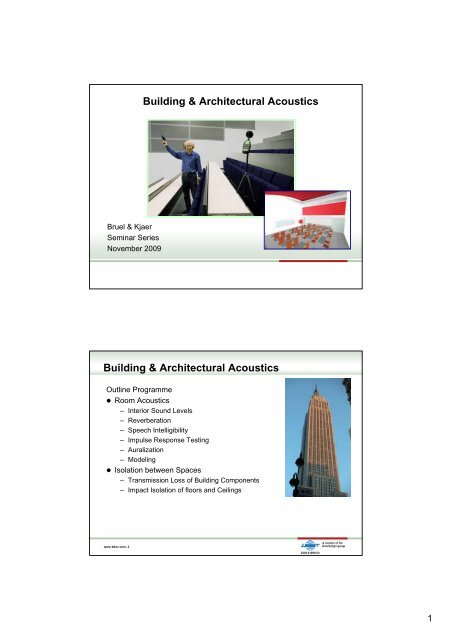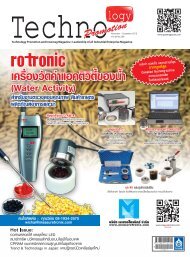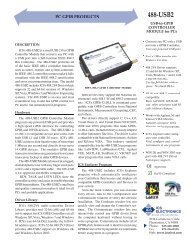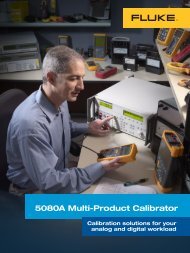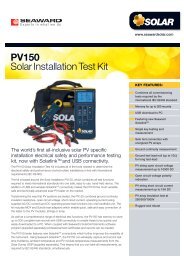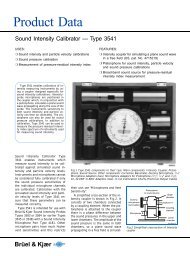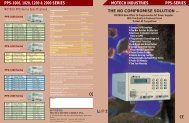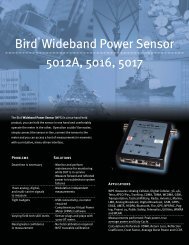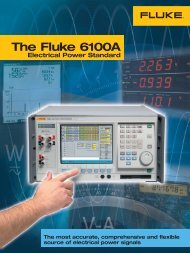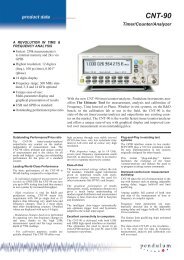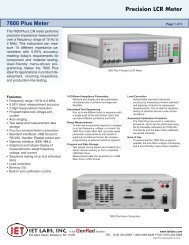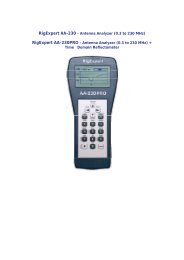Building & Architectural Acoustics Building & Architectural Acoustics
Building & Architectural Acoustics Building & Architectural Acoustics
Building & Architectural Acoustics Building & Architectural Acoustics
You also want an ePaper? Increase the reach of your titles
YUMPU automatically turns print PDFs into web optimized ePapers that Google loves.
<strong>Building</strong> & <strong>Architectural</strong> <strong>Acoustics</strong><br />
Bruel & Kjaer<br />
Seminar Series<br />
November 2009<br />
<strong>Building</strong> & <strong>Architectural</strong> <strong>Acoustics</strong><br />
Outline Programme<br />
• Room <strong>Acoustics</strong><br />
– Interior Sound Levels<br />
– Reverberation<br />
– Speech Intelligibility<br />
– Impulse Response Testing<br />
– Auralization<br />
– Modeling<br />
• Isolation between Spaces<br />
– Transmission Loss of <strong>Building</strong> Components<br />
– Impact Isolation of floors and Ceilings<br />
www.bksv.com, 2<br />
1
What is <strong>Architectural</strong> <strong>Acoustics</strong><br />
• Room <strong>Acoustics</strong> and <strong>Building</strong> Insulation<br />
• Room acoustics relate to the place you<br />
are – and how sound is perceived<br />
• <strong>Building</strong> Insulation is noise control to<br />
keep sound out of your room<br />
• Things we won’t talk about…<br />
– Machine Diagnostics<br />
– HVAC and mechanical system design<br />
– Only a little bit about building design<br />
www.bksv.com, 3<br />
Room <strong>Acoustics</strong>: Measure or Model<br />
www.bksv.com, 4<br />
2
Interior Sound Levels<br />
• A-weighted Sound Level<br />
• Octave Band Sound Pressure<br />
Level<br />
• NC, PNC, RC, NCB<br />
Figure 2 - Octave Band Sound Pressure Level Spectra Measured at Ortho Open Plan Office Area. Data of 17 December 2001 .<br />
70<br />
60<br />
Office S216<br />
Office S214<br />
Office S217<br />
Office S211<br />
NC 35<br />
NC 40<br />
50<br />
40<br />
30<br />
20<br />
10<br />
31.5 63 125 250 500 1000 2000 4000 8000 NC<br />
Oct ave Band Cent er Frequency, Hz<br />
www.bksv.com, 5<br />
Recommendations for acceptable Room Noise<br />
www.bksv.com, 6<br />
3
NCB and RC<br />
Balanced Noise Criteria (NCB) SIL 500,1K,2K,4K<br />
Room Criteria (RC) PSIL 500,1K,2K<br />
www.bksv.com, 7<br />
<strong>Building</strong> Vibration<br />
• Vibration Sensitivity of<br />
humans is at lower<br />
frequencies<br />
• Velocity is the measured<br />
parameter of vibration<br />
• Sometimes it’s the sound<br />
produced by vibration that<br />
is audible.<br />
www.bksv.com, 8<br />
4
Now ready, set, go!<br />
Reverberation!<br />
www.bksv.com, 9<br />
Reverberation Parameters<br />
level<br />
dB<br />
First 10dBEDT<br />
Evaluation range 20 dB T20<br />
0 dB<br />
-5 dB<br />
or 30dB T30<br />
60dB<br />
time s<br />
Reverberation Time T60<br />
ALL VALUES ARE NORMALIZED TO T60<br />
www.bksv.com, 10<br />
5
Reverberation Time and Absorption<br />
V<br />
T 0. 161<br />
A<br />
T is Reverberation Time<br />
- Sound decay in seconds to 1/1000<br />
level (-60dB)<br />
V is the Volume of the Room (m 3 )<br />
A is the Total Absorption Area (m 2 )<br />
Wallace Clement Sabine (June 13, 1868 - January 10, 1919)<br />
www.bksv.com, 11<br />
Optimum Reverberation Times<br />
CNRC<br />
www.bksv.com, 12<br />
6
What makes a Good Listening Room<br />
• Steep Early Decay Curve<br />
– Maintains clarity<br />
• Early reflections<br />
– +/- 60 degree<br />
– Horizontal<br />
• Minimize ceiling reflections<br />
• Side Wall reflections<br />
– Discreet<br />
– Lateral<br />
• Eliminate<br />
– Discrete echoes<br />
– Flutter<br />
– Standing Waves<br />
s<br />
1<br />
0.9<br />
0.8<br />
0.7<br />
0.6<br />
0 0.4 0.8 1.2 1.6 2 2.4 2.8 3.2 3.6<br />
s<br />
0.5<br />
0.4<br />
0.3<br />
0.2<br />
0.1<br />
S1R1<br />
T2 Average<br />
250<br />
125<br />
500<br />
1k<br />
2k<br />
dB<br />
80<br />
60<br />
40<br />
20<br />
0<br />
4k<br />
Hz<br />
0<br />
125 250 500 1k 2k 4k<br />
Hz<br />
www.bksv.com, 13<br />
Factors Influencing Speech Intelligibility<br />
• Word Material and Presentation<br />
• Character of the Speaker<br />
• Quality of the Transmission System<br />
• Character of the <strong>Acoustics</strong><br />
• Character of the Listener<br />
www.bksv.com, 14<br />
7
Speech Intelligibility Measures<br />
• Articulation Index<br />
• Speech Interference Level (SIL,PSIL,SIL3)<br />
• Direct to Reverb ration (Weighted C50/C35)<br />
• Speech Intelligibility Index<br />
• Speech Transmission Index (STI)<br />
• Rapid Speech Transmission Index (RASTI)<br />
• %ALCONS<br />
(All consider signal to noise effects, some include reverberation, none<br />
explicitly include distortion in transmission system)<br />
www.bksv.com, 15<br />
Speech Intelligibility<br />
Percentage of words, syllables, phrases<br />
Understood<br />
Articulation Index<br />
www.bksv.com, 16<br />
8
Let’s try a simple measurement with a 2250<br />
www.bksv.com, 17<br />
The model 2250 from Bruel & Kjaer<br />
• Sound Level Meter Functions<br />
• Real-Time Frequency Analysis<br />
• Detailed Noise Level Analysis<br />
• High Quality Sound Recording<br />
• Reverberation Time Measurement<br />
www.bksv.com, 18<br />
9
Anechoic and Reverberant Enclosures<br />
www.bksv.com, 19<br />
860511/1<br />
Typical reverberation<br />
times<br />
at 500Hz in seconds<br />
Minimum<br />
Maximum<br />
Speech 0.4 1.0<br />
Music (Average) 1.0 1.6<br />
Churches (Average) 1.2 1.6<br />
Organ music 1.5 2.4<br />
Speech Intelligibility poor in reverberant environment<br />
Suitable environment<br />
10
Impulse - Pistol Shot<br />
Time<br />
www.bksv.com, 21<br />
Speech Clarity Measurement – then and now<br />
www.bksv.com, 22<br />
11
Let’s try a simple measurement with a 2250<br />
And a balloon ……<br />
www.bksv.com, 23<br />
12
Impulse Response the natural way<br />
Processing<br />
Unit<br />
Receiver<br />
Sound<br />
Source<br />
ROOM<br />
What can be improved <br />
www.bksv.com, 25<br />
Impulse Response - Improvements<br />
Processing<br />
Unit<br />
Receiver<br />
Sound<br />
Source<br />
ROOM<br />
What can be improved <br />
• Source/receiver locations<br />
• Source specifications<br />
• Receiver specifications<br />
• Measured parameters<br />
www.bksv.com, 26<br />
13
Source Signals for Impulse Response<br />
• Ideal Impulse (Dirac function)<br />
+ No postprocessing - Only theoretical<br />
• Approximated Impulse<br />
+ Simple, No postprocessing - Directivity, repeatability<br />
• Random Signal<br />
+ Simple - Postprocessing, Residual noise<br />
• MLS Signal<br />
+ SPL measurement - Postprocessing<br />
• Sine Sweep Signal<br />
+ High power - Postprocessing<br />
www.bksv.com, 27<br />
MLS - Why<br />
• MLS means Maximum Length Sequence<br />
It´s a pseudorandom binary sequence, widely used for “white noise”<br />
generation<br />
• The crest factor (Peak/RMS) is low,<br />
an advantage for a loudspeaker sound source<br />
• Convolve with microphone signal to get room impulse<br />
response<br />
• Suppress uncorrelated background noise by increasing<br />
sequence length (or repeating sequence) n times<br />
Suppression is n in theory<br />
Example :<br />
n 4<br />
Suppression<br />
n 2<br />
6dB<br />
www.bksv.com, 28<br />
14
What is DIRAC <br />
• Dual Input Room <strong>Acoustics</strong> Calculator<br />
• PC software<br />
• Single or dual channel measurements<br />
• Calculates room acoustical parameters<br />
• Follows ISO 3382 and IEC 60268-16<br />
Paul Adrien Maurice Dirac (1902-1984)<br />
The singular delta function was invented<br />
by Dirac, and is used in many different<br />
areas of mathematics, physics and<br />
acoustics.<br />
www.bksv.com, 29<br />
DIRAC Measurement (1)<br />
Sound Card Calibration<br />
• Connect Line Out to Line In<br />
• Start automatic calibration<br />
• Sound card control and specifications are tested and improved<br />
• Save calibration data for use in measurements<br />
• Measure loop-back response (“Dirac” impulse)<br />
www.bksv.com, 30<br />
15
DIRAC Measurement (2)<br />
www.bksv.com, 31<br />
DIRAC Measurement (3)<br />
Measurement Result:<br />
Impulse Response .wav file<br />
Postprocessing:<br />
Parameters are calculated<br />
from the .wav file<br />
www.bksv.com, 32<br />
16
Room Acoustic Standards<br />
• Room Parameters ISO 3382<br />
EDT, T20, T30, C80, D50, Ts, LF, LFC, IACC, G<br />
• Stage Parameters Gade<br />
STearly, STlate, STtotal<br />
• Speech ISO 60268-16<br />
STI, STIPA, STImale, STIfemale, STITEL, RASTI, ALC<br />
www.bksv.com, 33<br />
Room Acoustic Parameters - Value examples<br />
Recommended values for symphonic music in concert halls<br />
• Reverberation Time T30 1,7 - 2,3 s<br />
• Clarity C80 -1 to -3 dB<br />
• Strength G > 3 dB<br />
• Early Support STearly > -13 dB<br />
• Total Support STtotal > -12 dB<br />
Limit values for dwellings, public spaces and workspaces<br />
• Reverberation Time T30<br />
• Speech Intelligibility RASTI<br />
See building regulations<br />
See contract<br />
The values are from the ODEON user manual section 7<br />
www.bksv.com, 34<br />
17
Parameters - Speech STI scale<br />
STI Value<br />
1,00<br />
0,75<br />
0,60<br />
0,45<br />
0,30<br />
Subjective Scale<br />
Excellent<br />
Good<br />
Fair<br />
Poor<br />
Bad<br />
0,00<br />
www.bksv.com, 35<br />
Room Acoustic Parameters - Graphs (single)<br />
www.bksv.com, 36<br />
18
Room Acoustic Parameters - Graphs (multiple)<br />
www.bksv.com, 37<br />
3D Graphs - TSS Waterfall (Time Shifted Spectra)<br />
www.bksv.com, 38<br />
19
3D Graphs - TTS Spectrogram (Time Shifted Spectra)<br />
www.bksv.com, 39<br />
3D Graphs - CSD Waterfall (Cumulative Spectra Decay)<br />
www.bksv.com, 40<br />
20
3D Graphs - CSD Spectrogram (Time Shifted Spectra)<br />
www.bksv.com, 41<br />
Only 1 more thing to do with Implulse Response<br />
Auralization<br />
• Anechoic input signal<br />
p (%)<br />
• is convolved with BRIR<br />
Binaural Room Impulse Response<br />
60<br />
40<br />
20<br />
0<br />
-20<br />
-40<br />
-60<br />
-80<br />
60<br />
40<br />
20<br />
0,2<br />
0,25<br />
0,3<br />
Left ear<br />
0,35 0,4 0,45<br />
time (seconds)<br />
Right ear<br />
time (seconds)<br />
0,5<br />
0,55<br />
0,6<br />
p (%)<br />
0<br />
-20<br />
-40<br />
-60<br />
-80<br />
Decay curves<br />
0<br />
-5<br />
-10<br />
SPL (dB)<br />
-15<br />
-20<br />
-25<br />
-30<br />
-35<br />
-40<br />
-45<br />
-50<br />
-55<br />
0,2<br />
0,25<br />
0,3<br />
0,35<br />
0,4<br />
0,45<br />
0,5<br />
0,55<br />
0,6<br />
0 0,2 0,4 0,6<br />
0,8<br />
1<br />
1,2<br />
1,4<br />
1,6 1,8 2<br />
Time (seconds rel. direct sound)<br />
• to give sound at receiver<br />
Listen using headphones<br />
• Use for analysis and<br />
demonstration<br />
www.bksv.com, 42<br />
21
7<br />
8<br />
6<br />
5<br />
1234 13 14<br />
9<br />
10<br />
11<br />
12<br />
Modeling<br />
• You can model something that doesn’t exist!<br />
• You can model something that already exists<br />
– and “measure” before you go there.<br />
• Important: Garbage in Garbage out!<br />
1<br />
2<br />
1<br />
www.bksv.com, 43<br />
Modeling Applications<br />
• Concert halls<br />
• Opera halls<br />
• Foyers<br />
• Auditoria<br />
• Classrooms<br />
• Open plan offices<br />
• Stadiums (incl. open air)<br />
• Gymnasiums<br />
• Airport terminals<br />
• Train stations<br />
• Factory halls<br />
Room Dimension<br />
greater than<br />
3 W a v e l e n g t h s<br />
www.bksv.com, 44<br />
22
Calculated Results –<br />
Measurement Parameters and more<br />
• Analysis at selected Receiver<br />
• Auralization<br />
www.bksv.com, 45<br />
Modelling Advantage: Tracking down Echoes<br />
Directional Decay<br />
• Directional part of decay shown<br />
Activate by using the A shortcut<br />
• Click on reflection in decay to see its origin<br />
• Diffuse field<br />
if directional decay is 6 dB below energy decay and parallel<br />
• Non-diffuse field<br />
if less than 6 dB difference and narrowing<br />
www.bksv.com, 46<br />
23
Easy to do comparisons<br />
Multi Point Response<br />
• Analysis at selected Receivers<br />
• Comparisons and correlations<br />
• Noise Control assessment<br />
www.bksv.com, 47<br />
Area graphs<br />
SPL at 1000 Hz >60.0<br />
58.2<br />
Grid Response<br />
• Mapping of Receivers<br />
• Cumulative statistics<br />
• Fractile graph<br />
56.8<br />
55.4<br />
54.0<br />
52.6<br />
51.2<br />
49.8<br />
48.4<br />
95<br />
90<br />
85<br />
80<br />
75<br />
70<br />
65<br />
Cumulative distribution function<br />
1<br />
47.0<br />
45.6<br />
44.2<br />
Percent<br />
60<br />
55<br />
50<br />
45<br />
40<br />
35<br />
2<br />
42.8<br />
41.4<br />
30<br />
25<br />
20<br />
15<br />
10<br />
5<br />
Odeonฉ1985-2003<br />
Tools to improve your room acoustics<br />
Reflector Coverage<br />
• Shows Reflector coverage<br />
• Validates Reflector design<br />
www.bksv.com, 49<br />
Animation Tools<br />
3D Billard<br />
• Visualize wave-fronts<br />
• Investigate scattering effects<br />
• Investigate possible echo problems<br />
www.bksv.com, 50<br />
25
ODEON Animations, Cont.<br />
3D Investigate ray-tracing<br />
• Verify water tightness of geometry<br />
• Investigate scattering effects<br />
www.bksv.com, 51<br />
ODEON Results - Auralization<br />
Examples of Auralization<br />
• Flutter echo - before and after treatment<br />
• Underground train station with PA system<br />
• Classroom with and without acoustic treatment<br />
1<br />
1<br />
11<br />
10<br />
1<br />
2<br />
1<br />
9<br />
18<br />
2 8<br />
173<br />
12<br />
6<br />
www.bksv.com, 52<br />
26
ODEON Results - Auralization<br />
Flutter Echo in Concert Hall<br />
• Without diffusing panel<br />
• Diffusing panel removes echo<br />
Odeonฉ 1985-2003<br />
1<br />
1<br />
Source: 1<br />
Surface: *Receiver*<br />
Refl.: 3<br />
P a th : 30.35<br />
Time : 88<br />
Without diffusor<br />
With diffusor<br />
ODEON Results - Auralization<br />
0.00 20.00 40.00 60.00 80.00 100.00 metres<br />
32<br />
10 9<br />
2<br />
8<br />
6<br />
Underground Station<br />
• Train noise from line source<br />
• Speech from four loudspeakers<br />
www.bksv.com, 54<br />
27
ODEON Underground Station<br />
Train stopping<br />
• Loudspeaker message<br />
• Noise from passing train<br />
• Reverberation time 8 s<br />
Train anechoic recording<br />
Speech anechoic recording<br />
www.bksv.com, 55<br />
ODEON School Project<br />
Classroom Model<br />
www.bksv.com, 56<br />
28
ODEON School Project<br />
Original <strong>Acoustics</strong><br />
www.bksv.com, 57<br />
ODEON School Project<br />
Absorption Added<br />
www.bksv.com, 58<br />
29
ODEON School Project<br />
Absorption and Reflector Added<br />
Flutter Echo<br />
www.bksv.com, 59<br />
What are <strong>Building</strong> <strong>Acoustics</strong><br />
• A part of the Community Comfort<br />
Market (B&K’s definition)<br />
• A part of the <strong>Architectural</strong> <strong>Acoustics</strong><br />
applications and interior noise and<br />
noise control.<br />
• Concerned with building quality and<br />
community noise annoyance<br />
• Which is a big part of the consulting<br />
work done by acoustical consultants<br />
www.bksv.com, 60<br />
30
A bit of terminology<br />
• Noise reduction is the difference between the sound level at point A<br />
and point B<br />
• Transmission Loss is the reduction in sound power as it is transmitted<br />
between point A and point B<br />
– TL = L wincident<br />
–L wtransmitted<br />
• Insertion loss is the difference in sound level before and after a<br />
“modification”<br />
• A<br />
• B<br />
www.bksv.com, 61<br />
Sound Power Transmission<br />
• Sound Transmission Coefficient = = Wt/Wi<br />
• Transmission Loss = TL=10*log(1/ <br />
• Wi<br />
• Wt<br />
www.bksv.com, 62<br />
31
Multiple Layer Walls increase Transmission Loss<br />
• TL~20log(f)+20log(M) – 47<br />
• TL~20*log(Md)+34 (at 500 Hz)<br />
• At 500 Hz<br />
– Solid with M=10kg/sq.m.<br />
» 27 dB<br />
– Two layers together<br />
» 34 dB<br />
– Two layers and separate by 10 cm<br />
» 40 dB<br />
www.bksv.com, 63<br />
Multiple layers introduce new “resonances<br />
www.bksv.com, 64<br />
32
Cavity Resonances<br />
www.bksv.com, 65<br />
Complex Walls<br />
www.bksv.com, 66<br />
33
Sweating the Details<br />
www.bksv.com, 67<br />
Standard Ratings of Isolation<br />
• STC- Standard Transmission Class<br />
www.bksv.com, 68<br />
34
Isolation Between Spaces<br />
• Regulations<br />
– Unified <strong>Building</strong> Code – STC 45<br />
• Use Driven<br />
– Speech Isolation<br />
STC<br />
25<br />
30<br />
35<br />
42<br />
45<br />
50<br />
Hearing Quality<br />
Normal speech understood<br />
Normal speech heard/ Loud speech<br />
understood<br />
Loud speech heard<br />
Loud speech audible<br />
Loud speech not audible<br />
Stereo just heard<br />
www.bksv.com, 69<br />
Isolation Between Spaces (cont.)<br />
– NC Goal (or hearing protection) for other than speech isolation<br />
» Lp(in source room) –NC=NR<br />
» NR=TL+10log(Sw/A)<br />
– Select wall construction meeting TL goal from literature<br />
» Get manufacturer test data<br />
» Don’t try to calculate yourself<br />
» Add 5 dB for safety factor<br />
» Remember STC is for speech!!! What are you isolating<br />
www.bksv.com, 70<br />
35
<strong>Building</strong> Acoustic Measurement Tasks…<br />
But also… troubleshooting noise problems (FFT – sound and vibration),<br />
assessing noise levels relative to the purpose of the room (Noise Criteria, EDT,<br />
Speech Intelligibility, etc.) and occasionally using sound-intensity to identify<br />
leaks and noise sources.<br />
www.bksv.com, 71<br />
Types of Measurement<br />
A<br />
S<br />
T<br />
M<br />
S<br />
T<br />
D<br />
• Airborne sound insulation ............<br />
• Impact sound level ……<br />
• Facade insulation .............................<br />
• Installation noise .....<br />
• Reverberation time ...........................<br />
www.bksv.com, 72<br />
36
Airborne Sound Insulation - Measurements<br />
Source Room Receiving Room<br />
Room 1 Room 2<br />
Source Room<br />
Level .......................... L1<br />
T2<br />
B2 .......Background Noise Level<br />
L2 ...............Receiving Room Level<br />
.......................Reverberation Time<br />
Partition<br />
www.bksv.com, 73<br />
Calculating sound insulation<br />
Example: Sound Transmission Loss<br />
S is partition area<br />
S<br />
B2<br />
L1<br />
L2<br />
V<br />
T2<br />
V is Receiving Room volume<br />
Sound Transmission Loss<br />
R = L1 - L2(B2) + 10 log(ST/0.16V)<br />
R dB<br />
... this is a 1/3 octave Transmission Loss (TL) spectrum<br />
(without the Absorption correction it is called a<br />
Noise Reduction (NR) Spectrum)<br />
www.bksv.com, 74<br />
37
Calculating sound insulation: weighting<br />
Read result STC<br />
at 500 Hz<br />
NRdB<br />
Place weighting curve to make<br />
sum of Deficiencies < 32dB<br />
(1band < 8dB)<br />
Reference<br />
curve<br />
500Hz<br />
Hz<br />
STC: Weighted Sound Transmission Class<br />
- single number, e.g. 52 dB<br />
www.bksv.com, 75<br />
Impact Sound Level - Measurements<br />
Similar to Airborne, except:<br />
• L1 is not measured<br />
• Tapping machine is used<br />
Source Room Receiving Room<br />
Room 1 Room 2<br />
Tapping<br />
Machine ................<br />
B2 ......Background Noise Level<br />
L2 .............Receiving Room Level<br />
T2......................Reverberation Time<br />
..............Used only for T2<br />
www.bksv.com, 76<br />
38
Instrument Requirements<br />
Investigator<br />
Type 2260D<br />
<strong>Building</strong><br />
<strong>Acoustics</strong><br />
Software<br />
BZ7204<br />
• Pink and white noise generator<br />
• Measure<br />
– 1/3 and 1/1 octave bands (depending on standard)<br />
– level and reverberation time spectra<br />
• Calculation and display of......<br />
– Average of positions<br />
– Sound reduction spectra (R’, DnT, NR, FTL....)<br />
– Weighted indices (R’w, DnTw, NIC, FSTC,.....)<br />
– Reverberation Time and Decay Curves<br />
• ....according to the following standards<br />
– ISO, SS, DIN, ÖNORM, BS, Sia, UNI, NF, UNE, NEN,<br />
ASTM<br />
The 2260 Investigator has it all<br />
www.bksv.com, 77<br />
Now the 2250 and 2270 have it all, too!<br />
• Single (BZ7228) or Dual<br />
Channel Applications<br />
available (BZ7229)<br />
• Single Channel on 2250 or<br />
2270; Dual Channel on Type<br />
2270 ONLY<br />
• Systems and kits (add-ins)<br />
available<br />
• Same accessory and cables<br />
as Type 2260D building<br />
acoustics systems<br />
• With a few advantages…<br />
www.bksv.com, 78<br />
39
Type 2250<br />
• Single-channel measurements<br />
• Sound recording<br />
• Posibility to add spoken or written<br />
comments<br />
to measurements<br />
Optional software: BZ5503 and Qualifier type 7830. Software for reporting<br />
and post processing of results from Type 2260D (<strong>Building</strong> <strong>Acoustics</strong><br />
Application)<br />
www.bksv.com, 79<br />
Type 2270 & 2250<br />
2270 only :<br />
• Camera option to document<br />
the test environment<br />
• Up to two-channels<br />
2270 and 2250 :<br />
• Built-in pink and white<br />
noise generator<br />
• Equalisation of sound<br />
source spectra<br />
• Position management<br />
and sound recording<br />
www.bksv.com, 80<br />
40
New for Euronoise 2009<br />
• Introducing the new Type 2734 light-weight, high power amplifier<br />
– 7Kg Mass<br />
– Built-in pink & white noise generator<br />
– Class D 500 W specification<br />
– Wireless remote control<br />
– Wireless source signal transmission<br />
www.bksv.com, 81<br />
The Advanced <strong>Building</strong> <strong>Acoustics</strong> Analyzer<br />
Dual parameter display of L1, L2, B2 or L1-L2<br />
or L2-B2 as well as the current position<br />
measurement of a live LZF spectrum<br />
Broadband level measurements<br />
Simple touch screen navigation between<br />
displays.<br />
www.bksv.com, 82<br />
41
Results Overview Screen<br />
An easy to see overview<br />
of the many<br />
measurements in a<br />
<strong>Building</strong> <strong>Acoustics</strong><br />
Project<br />
Touch a warning for its<br />
description.<br />
We can now keep track<br />
of measurements when<br />
we move the source to a<br />
second position<br />
Check or uncheck<br />
measurements to be<br />
included in the calculated<br />
results..<br />
www.bksv.com, 83<br />
Results Calculations Screen<br />
Select the Calculated<br />
spectrum here<br />
Show the result with or<br />
without the reference<br />
curve.<br />
See the one number<br />
calculated NIC or STC<br />
Here<br />
www.bksv.com, 84<br />
42
BZ5503 – Archive results as normal<br />
Then: Export the results<br />
to Excel<br />
www.bksv.com, 85<br />
Use BZ5503 to view calculated results<br />
www.bksv.com, 86<br />
43
PULSE Reflex <strong>Building</strong> <strong>Acoustics</strong> Reporting<br />
www.bksv.com, 87<br />
Pulse Reflex – Versatile, Powerful, Intuitive Post Processing<br />
Type 2250<br />
Type 2270<br />
Type 2260<br />
www.bksv.com, 88<br />
44
Combine Results<br />
www.bksv.com, 89<br />
Export to Qualifier<br />
www.bksv.com, 90<br />
45
Freedom to move - Wireless Control<br />
Pocket Transmitter<br />
Wireless Transmission Kit<br />
Through any partition<br />
Receiver<br />
Power Amplifier 2716 Loudspeaker 4292<br />
www.bksv.com, 91<br />
Sound Sources<br />
Omni-<br />
Source<br />
Omni-<br />
Power<br />
1 Speakers 12<br />
3.5 kg Weight 14 kg<br />
105 dB Lw 122 dB<br />
OmniSource is for room acoustics<br />
OmniPower is for sound insulation<br />
www.bksv.com, 92<br />
46
Let’s take a tour…<br />
www.bksv.com, 93<br />
Summing up<br />
Today we’ve looked at measuring and modeling<br />
<strong>Architectural</strong> Acoustical behavior. Brüel & Kjær<br />
offers a range of tools to assist the acoustician<br />
is assessing a condition and offering solutions<br />
www.bksv.com, 94<br />
47
25 Years Providing High Quality<br />
<strong>Building</strong> <strong>Acoustics</strong> Measurement<br />
Solutions<br />
1980 1989 1996 2009<br />
48


